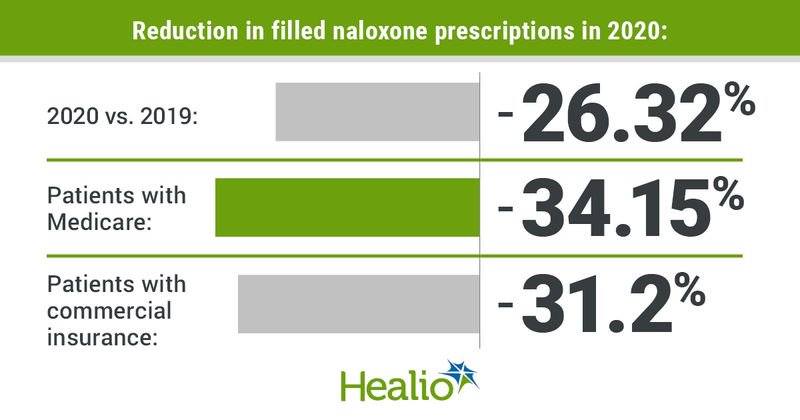Rate of filled naloxone prescriptions dropped during pandemic
Researchers observed a substantial reduction in filled naloxone prescriptions that exceeded a reduction in filled opioid prescriptions and filled prescriptions for any medication during the COVID-19 pandemic.
“Substance use, including opioid use, increased during the COVID-19 pandemic,” Ashley L. O’Donoghue, PhD, an economist at Beth Israel Deaconess Medical Center in Boston, and colleagues wrote. “While overall emergency department visits decreased during the pandemic, nonfatal opioid overdose visits more than doubled, but few patients who overdosed on opioids received naloxone prescriptions on discharge.”

Data derived from: O’Donoghue AL, et al. JAMA Health Forum. 2021;doi:10.1001/jamahealthforum.2021.0393.
O’Donoghue and colleagues conducted a cohort study using deidentified data from the Symphony Health pharmacy claims database from May 2019 to December 2020. The researchers compared the number of filled naloxone prescriptions from May 13, 2019, to March 13, 2020, with the number of prescriptions filled after a national emergency was declared in the U.S. through the end of the calendar year. Weeks with a national holiday, including Thanksgiving, Christmas and New Year’s Day, were excluded from the analysis, the researchers wrote.
There was an “abrupt” 26.32% reduction in the number filled naloxone prescriptions in March 2020, which outpaced the 14.76% reduction in prescriptions filled for any medication and the 8.71% reduction in filled opioid prescriptions, according to the researchers. Filled naloxone prescriptions decreased by 34.15% among patients with Medicare and 31.2% among patients with commercial insurance, but there were no statistically significant differences among patients who had Medicaid or paid cash, the researchers wrote.
“Our study identifies an urgent gap in necessary access to medication for individuals on Medicare and commercial insurance during the pandemic,” the researchers wrote. “Continuing to increase naloxone distribution in densely populated areas and via mail order and delivery through community-based organizations could help to mitigate some of the reductions in naloxone distribution via pharmacies and could reduce some of the increases in fatal opioid overdoses during the COVID-19 pandemic.”

